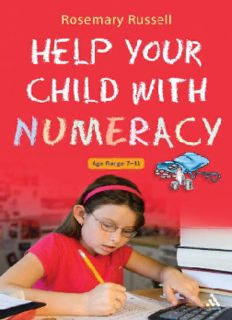
Help Your Child With Numeracy Ages 7-11 PDF
Preview Help Your Child With Numeracy Ages 7-11
Help Your Child with Numeracy Ages 7–11 Also available from Continuum Help Your Child with Numeracy Ages 3–7, Rosemary Russell Help Your Child with Literacy Ages 3–7, Caroline Coxon Help Your Child with Literacy Ages 7–11, Caroline Coxon Available from Network Continuum Help Your Boys Succeed, Gary Wilson Help Your Child Develop Emotional Literacy, Betty Rudd Help Your Child to Succeed, Bill Lucas and Alistair Smith Help Your Talented Child, Barry Teare Help Your Young Child to Succeed, Ros Bayley, Lynn Broadbent and Debbie Pullinger Help Your Child with Numeracy Ages 7–11 Rosemary Russell Continuum International Publishing Group TheTowerBuilding,11YorkRoad,LondonSE17NX 80MaidenLane,Suite704,NewYork,NY10038 www.continuumbooks.com ©RosemaryRussell2009 Allrightsreserved.Nopartofthispublicationmaybereproducedor transmittedinanyformorbyanymeans,electronicormechanical, includingphotocopying,recording,oranyinformationstorageor retrievalsystem,withoutpriorpermissioninwritingfromthepublishers. RosemaryRussellhasassertedherrightundertheCopyright,Designs andPatentsAct,1988,tobeidentifiedasAuthorofthiswork. British Library Cataloguing-in-Publication Data AcataloguerecordforthisbookisavailablefromtheBritishLibrary. ISBN:9781847064127(paperback) Library of Congress Cataloging-in-Publication Data AcatalogrecordforthisbookisavailablefromtheLibraryofCongress. DesignedandtypesetbyKennethBurnley,Wirral,Cheshire PrintedandboundinGreatBritainby1010PrintingInternationalLtd Contents Introduction 1 Maths is good for you! 1 How this book will help 1 Moving on 1 The most important help – providing the right environment 2 Everyday maths 3 Start from where they are 3 Lots of ways to learn 4 Praise and encouragement – building self-esteem 5 Great expectations – but not too great! 5 Schools 7 National Curriculum 7 Key Stages 7 Numeracy Strategy (The Primary Framework for Mathematics) 7 Numeracy Hour 11 Typical lessons 11 SATs and assessment 12 Levels 12 Using and applying mathematics 13 Background 13 Strategies to help 13 Break down the problem into simple steps 13 One-step, two-step and multi-step problems 13 Understand what the problem is about 15 Understand what calculations are required 15 How you can help your child 16 Counting and understanding number 17 Background 17 Units, tens, hundreds and thousands: how our number system works 18 An extract from our number system 19 Rewriting a number in smaller units 20 Starting off 20 Decimals 21 Multiplying and dividing by 10, 100, 1000* 22 Multiplying decimals by 10, 100, 1000* 23 Division by 10, 100, 1000* 24 Useful mental arithmetic skills 25 Ordering numbers and the symbols > and < 25 Counting in different steps 26 Negative numbers 26 Making connections – sequences 26 Ordering decimals 27 Fractions, decimals and percentages 28 Equivalent fractions 28 Finding a fraction of an amount* 30 Decimal fractions 30 Percentages 31 Finding a percentage of an amount* 31 Ratio and proportion 32 Estimation 34 How to make an estimate 34 Starting off 34 Rounding 35 The rule for rounding 36 Knowing and using number facts 37 Knowing number facts and doubling and halving 37 Learning tables 38 Inverse operations 38 Estimating and checking calculations 39 Using inverse operations 39 Using rounding to get an approximation 40 Calculating 41 Written methods 41 Stages in learning addition 42 Carrying 43 Extending addition skills to using decimals 44 Subtraction 46 Many methods of subtraction 46 Stages in teaching subtraction 47 Easier subtractions 47 vi Subtraction: the two main methods 48 Subtraction by decomposition 48 Subtraction by equal addition 49 Harder subtractions using the decomposition method of subtraction 50 How to deal with zeros when subtracting 52 Decomposition 52 Equal addition 53 Subtraction using decimals 55 Multiplication 55 Steps in mastering a written method of multiplication 56 Vertical format 59 Division 60 Background 60 Using a number line 61 Using ‘chunking’ 62 Using a standard (traditional) form 62 Chunking for larger numbers 63 How does ‘chunking’ compare with the traditional method? 64 Understanding shape 67 Background 67 Angles 68 Types of angles 68 Measuring angles 69 How to use a protractor 69 Calculating angles on a straight line 71 Angles in a triangle 72 Demonstration of angles in a triangle adding up to 180° 73 Measuring 75 Background 75 How to convert between metric units 75 Metric and imperial units 76 Reading scales 77 Area and perimeter 77 What is the perimeter of a shape? 78 Compound shapes 78 vii Understanding the difference between the area and perimeter 79 How the concept of area is taught 80 Calculating areas of rectangles 80 Use of formulae 81 Compound areas 81 Time 82 24-hour clock and 12-hour clock 83 Lengths of journeys using 24-hour clock 84 How to help your child 86 Handling data 87 Background 87 Average 88 The range 88 Types of averages 88 The mode 88 The mean 89 Probability 90 How is probability taught in schools? 90 How to help your child 91 Glossary 92 Appendix 1 – Multiplication square 96 Appendix 2 – Useful resources 98 Appendix 3 – Metric/Imperial conversions 100 Appendix 4 – Workout answers 101 viii Introduction Maths is good for you! Research has shown that: (cid:2) Numeracy exercises are very good for the brain (cid:2) In the long term, this helps employment prospects (cid:2) Maths qualifications can lead to more earning power. How this book will help This book will explain some of the milestones children make between the ages of 7 and 11 years old. It is not a text book! It will: (cid:2) Secure your own knowledge (cid:2) Show you what schools are trying to do (cid:2) Give you ideas of how to help (cid:2) Provide exercises (Workouts!) to do with your child (cid:2) Lead you to more resources. Moving on This book builds on Help Your Child with Numeracy Ages 3–7, and often refers back to it. Some things – especially in this introduction – are repeated because they are true 1
Description: